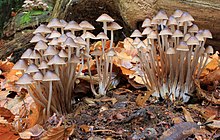
Back Mycena inclinata CEB Bonet glystyrog Welsh Mycena inclinata Esperanto Mycena inclinata Spanish Mycena inclinata Basque کلاهپارچهای خوشهای Persian Tammihiippo Finnish Mycène incliné French Cifra kígyógomba Hungarian Mycena inclinata Italian
| Mycena inclinata | |
|---|---|

| |
| Scientific classification | |
| Domain: | Eukaryota |
| Kingdom: | Fungi |
| Division: | Basidiomycota |
| Class: | Agaricomycetes |
| Order: | Agaricales |
| Family: | Mycenaceae |
| Genus: | Mycena |
| Species: | M. inclinata
|
| Binomial name | |
| Mycena inclinata | |
| Synonyms[1] | |
|
Agaricus inclinatus Fr. (1838) | |
| Mycena inclinata | |
|---|---|
| Gills on hymenium | |
| Cap is conical | |
| Hymenium is adnate | |
| Stipe is bare | |
| Spore print is white | |
| Ecology is saprotrophic | |
| Edibility is unknown | |
Mycena inclinata, commonly known as the clustered bonnet or the oak-stump bonnet cap, is a species of mushroom in the family Mycenaceae. The doubtfully edible mushroom has a reddish-brown bell-shaped cap up to 4.5 cm (1.8 in) in diameter. The thin stem is up to 9 cm (3.5 in) tall, whitish to yellow-brown at the top but progressively becoming reddish-brown towards the base in maturity, where they are covered by a yellowish mycelium that can be up to a third of the length of the stem. The gills are pale brown to pinkish, and the spore print is white. It is a widespread saprobic fungus, and has been found in Europe, North Africa, Asia, Australasia, and North America, where it grows in small groups or tufts on fallen logs and stumps, especially of oak. British mycologist E.J.H. Corner has described two varieties of the mushroom from Borneo. Lookalike species with which M. inclinata may be confused include M. galericulata and M. maculata.